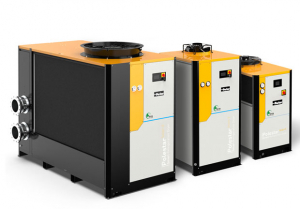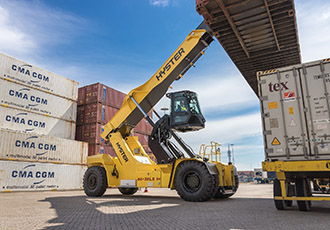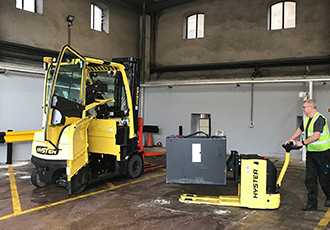Technology update increases versatility and capacity of robot cell

Re-engineering a straight-forward robot palletising cell after only five years might seem excessive but for one manufacturer rethinking this operation, and utilising newer technology, has paid dividends.
Myson Radiators based in Gateshead, manufactures over one million steel panel radiators a year. Six years ago it took a major step forward by installing a three robot palletising system. Engineered by a local company the system was capable of palletising 70% of Myson’s extensive range of products – in all over 923 variants of radiator.
Robbie Forrest, Process Engineer, Myson, explains, “We learnt a great deal from this system, least of all that the robots, in this case three FANUC M410iA robots, were under utilised and totally reliant on the speed of the pallet feed conveyors and pallet dispensers. Palletising also relied on radiators being loaded accurately against mechanical stops onto an input conveyor.”
Products also had to be placed onto the correct input conveyor as each cell had specific products that it could handle. The safety system and pallet arrangement around each robot meant that if a problem occurred anywhere in the cell the robot had to stop operating until the problem had been fixed.”
After five years of the system being in production, Myson’s engineers decided to capitalise on their understanding of the systems limitations and the knowledge they had gained on robotics. A clear objective for the new system was that each robot needed to be able to handle as much of the complete range as possible – having to segregate specific products to specific robots was not acceptable as this was a major contributor to under utilisation.
FANUC Robotics UK were contacted to discuss the suitability of using a vision system to identify radiator position on the input conveyor – achieving this would mean that each cell would be able to handle the complete range of products – an immediate benefit – and that placement inaccuracies would cease to be an issue.
FANUC engineers conducted vision system trials with Myson, firstly to prove that the camera could accommodate the large variance in length of radiator – from 300mm to 2,200mm – and secondly to define an optimum height for the camera.
The second core objective was to simplify, and in turn speed up, the pallet dispensing process. The original need for dispensers was driven by the requirement to totally isolate operators from the robot’s working envelope such that pallets could be automatically positioned in and removed from the cell.
Working closely with a guarding supplier and FANUC Robotics, this was overcome by defining two safety zones on either side of the robot’s working envelope. On the robots base two safety cam switches are fitted to axis one to control the status of the two safety zones – one in each of the palletising positions.
A laser scanner guarding system allows open access to the cell palletising area. If an operator attempts to enter a zone where the robot is palletising the system performs an E-stop. Under normal operating conditions an operator is able to enter the cell, to remove a full pallet, as the robot is mechanically aware of its position and is in control of the laser guard.
One single robot system is now fully functioning at Myson and the other two FANUC robots will shortly be commissioned into identical cells. Continuing, Robbie Forrest summarises, “Out of the 923 different radiators, we’ve now programmed 80% of them; the intention is to programme 100%. Programming is very straight-forward and we plan to hand this responsibility over to the cell operator.
“Implementing the vision and safety technology has allowed the robot to achieve its real potential. Regardless of radiator size the robot is consistently positioning product onto the pallet within ±3mm – this gives us a much neater stacked pallet and prevents packaging damage caused by misalignments.
“Capacity of the system has increased dramatically – we know that the cycle time averages out, across the full range, to 6.3 seconds and this gives us a potential of 4,000 radiators per 8 hour shift per robot. The cycle time and repeatability of placement is even more remarkable when considering not only the range of sizes but also variance in weight from 5 Kgs to 80 Kgs.”
Robbie Forrest, Process Engineer, Myson, explains, “We learnt a great deal from this system, least of all that the robots, in this case three FANUC M410iA robots, were under utilised and totally reliant on the speed of the pallet feed conveyors and pallet dispensers. Palletising also relied on radiators being loaded accurately against mechanical stops onto an input conveyor.”
Products also had to be placed onto the correct input conveyor as each cell had specific products that it could handle. The safety system and pallet arrangement around each robot meant that if a problem occurred anywhere in the cell the robot had to stop operating until the problem had been fixed.”
After five years of the system being in production, Myson’s engineers decided to capitalise on their understanding of the systems limitations and the knowledge they had gained on robotics. A clear objective for the new system was that each robot needed to be able to handle as much of the complete range as possible – having to segregate specific products to specific robots was not acceptable as this was a major contributor to under utilisation.
FANUC Robotics UK were contacted to discuss the suitability of using a vision system to identify radiator position on the input conveyor – achieving this would mean that each cell would be able to handle the complete range of products – an immediate benefit – and that placement inaccuracies would cease to be an issue.
FANUC engineers conducted vision system trials with Myson, firstly to prove that the camera could accommodate the large variance in length of radiator – from 300mm to 2,200mm – and secondly to define an optimum height for the camera.
The second core objective was to simplify, and in turn speed up, the pallet dispensing process. The original need for dispensers was driven by the requirement to totally isolate operators from the robot’s working envelope such that pallets could be automatically positioned in and removed from the cell.
Working closely with a guarding supplier and FANUC Robotics, this was overcome by defining two safety zones on either side of the robot’s working envelope. On the robots base two safety cam switches are fitted to axis one to control the status of the two safety zones – one in each of the palletising positions.
A laser scanner guarding system allows open access to the cell palletising area. If an operator attempts to enter a zone where the robot is palletising the system performs an E-stop. Under normal operating conditions an operator is able to enter the cell, to remove a full pallet, as the robot is mechanically aware of its position and is in control of the laser guard.
One single robot system is now fully functioning at Myson and the other two FANUC robots will shortly be commissioned into identical cells. Continuing, Robbie Forrest summarises, “Out of the 923 different radiators, we’ve now programmed 80% of them; the intention is to programme 100%. Programming is very straight-forward and we plan to hand this responsibility over to the cell operator.
“Implementing the vision and safety technology has allowed the robot to achieve its real potential. Regardless of radiator size the robot is consistently positioning product onto the pallet within ±3mm – this gives us a much neater stacked pallet and prevents packaging damage caused by misalignments.
“Capacity of the system has increased dramatically – we know that the cycle time averages out, across the full range, to 6.3 seconds and this gives us a potential of 4,000 radiators per 8 hour shift per robot. The cycle time and repeatability of placement is even more remarkable when considering not only the range of sizes but also variance in weight from 5 Kgs to 80 Kgs.”
Downloads
Similar articles
More from FANUC Robotics
- The 'strongest' robot in the world 12th June 2015
- FANUC receive award for thriving apprentice programme 28th February 2013
- Greenvale capitalise on robot’s flexibility 24th June 2011
- Robot gets to grips with flexible PVC floor tiles 10th March 2011




.jpg)







Write a comment
No comments